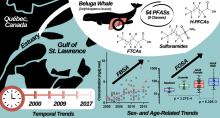| Title | Identification of Chemicals that Cause Oxidative Stress in Oil Sands Process-Affected Water. |
| Publication Type | Journal Article |
| Year of Publication | 2017 |
| Authors | Sun, J, Peng, H*, Alharbi, HA, Jones, PD, Giesy, JP, Wiseman, SB |
| Journal | Environ Sci Technol |
| Volume | 51 |
| Issue | 15 |
| Pagination | 8773-8781 |
| Date Published | 2017 Aug 01 |
| ISSN | 1520-5851 |
| Keywords | Animals, Carboxylic Acids, Oil and Gas Fields, Oryzias, Oxidative Stress, Water, Water Pollutants, Chemical |
| Abstract | Oil sands process-affected water (OSPW) has been reported to cause oxidative stress in organisms, yet the causative agents remain unknown. In this study, a high-throughput in vitro Nrf2 reporter system was used, to determine chemicals in OSPW that cause oxidative stress. Five fractions, with increasing polarity, of the dissolved organic phase of OSPW were generated by use of solid phase extraction cartridges. The greatest response of Nrf2 was elicited by F2 (2.7 ± 0.1-fold), consistent with greater hydroperoxidation of lipids in embryos of Japanese medaka (Oryzias latipes) exposed to F2. Classic naphthenic acids were mainly eluted in F1, and should not be causative chemicals. When F2 was fractionated into 60 subfractions by use of HPLC, significant activation of Nrf2 was observed in three grouped fractions: F2.8 (1.30 ± 0.01-fold), F2.16 (1.34 ± 0.05-fold), and F2.25 (1.28 ± 0.15-fold). 54 compounds were predicted to be potential chemicals causing Nrf2 response, predominated by SO and O species. By use of high-resolution MS spectra, these SO and O species were identified as hydroxylated aldehydes. This study demonstrated that polyoxygenated chemicals, rather than classic NAs, were the major chemicals responsible for oxidative stress in the aqueous phase of OSPW. |
| DOI | 10.1021/acs.est.7b01987 |
| Alternate Journal | Environ. Sci. Technol. |
| PubMed ID | 28661683 |
Environmental Chemical Biology

